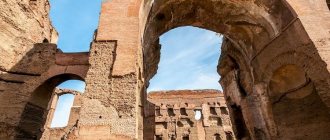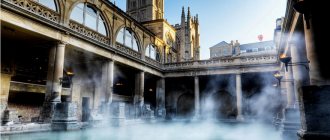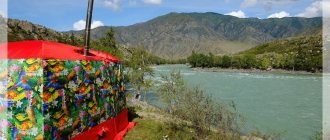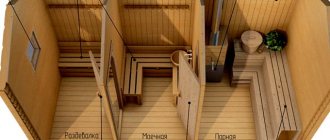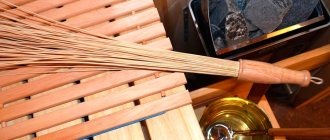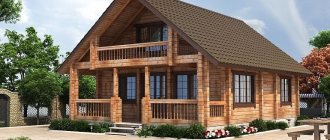Among the most popular and visited places by the Romans were the monumental public buildings for sanitary purposes. Roman baths were intended not only for performing water procedures, but were also the main tool for socialization. The Romans often visited the baths in order to socialize, make new acquaintances, play sports, resolve any issues and simply have fun in a pleasant atmosphere.
- Bath architecture
- Bath structure
- Thermal practices
- Games
- Cleansing
- Hydrotherapy and relaxation
- Visitors to the baths
From the second century BC, the ancient baths of Rome became increasingly important in the lives of citizens and constituted one of the main meeting places during the Empire. Such success of public baths was due to the fact that absolutely all segments of the population had access to them. In addition, visiting the baths in ancient times was completely free.
The most valuable example of the architecture of Roman baths, preserved in Rome in relatively good condition, is the thermal complex built by Emperor Caracalla in the second decade of the 3rd century, as well as the grandiose baths of Diocletian, built at the beginning of the 4th century. Both thermal complexes are striking in their size: the first occupied an area of about 11 hectares, the second - about 16! On the territory there were bathing halls, where there were baths with water of different temperatures, sports grounds and rooms for various purposes: for massage treatments, for playing ball, wrestling, library buildings and even pagan sanctuaries. Roman baths were like entire cities, where everyone could find something to their liking.
More about Roman Baths
Roman baths today are associated with luxury and an elite way of spending time. However, their story did not begin so magnificently. The prerequisite for the creation of a public bath was the terrible unsanitary conditions of commoners during the change of eras.
The commander Agrippa was the first to order the construction of a bathhouse, and then the baths were absolutely free and were intended mainly for the common people.
However, very soon the baths turned into something more than just ablution rooms.
They began to build in the baths:
- sports halls;
- libraries;
- massage rooms;
- theater halls;
- canteens, or rather ancient analogues of modern restaurants.
Thanks to such a variety of leisure activities, Roman citizens simply stayed in the baths for the whole day; no one was bored.
Interesting fact! Despite the fact that baths soon began to be built for the elite of Rome, and these buildings were much more luxurious, the basic internal structure of the premises was the same.
What is inside?
The Roman bath consisted of several rooms with different conditions:
- To begin with, visitors found themselves in a locker room called apodytherium. This room was cool, the temperature did not even reach 30°C. Clothes were supposed to be left here.
- Next we had to visit the washroom called the tepidarium. It was already much warmer here, up to 40°C, and the humidity also reached 40%.
- The next room to visit was the callidarium. It was already a kind of steam room with a temperature of up to 70°C. In addition, there was high humidity inside. Its value could reach 100%. There was also supposed to be a pool inside with water from a thermal spring.
- Another steam room is Laconium. This room was dry and with a high temperature, up to 85°C. Very similar to a Finnish sauna.
- After such intense steaming and warming up, it was necessary to visit the cool frigidarium room. It housed 2 swimming pools with warm and cold water for useful contrast treatments.
- And finally, the lavarium awaited visitors. This is a special room for cosmetic procedures. Here the Romans were massaged, rubbed with aromatic oils, covered in clay, etc.
On a note! It was thanks to the presence of a thermal spring inside that the Roman bath received the name “therms”. Hot water from natural springs was used to warm up rooms, fill swimming pools, and use it for ablutions.
Peculiarities
As you can see, the main feature of the Roman bath in ancient times was the thermal spring.
The system worked smoothly:
- Natural water, already heated to 40°C, was supplied to the bathhouse through a system of pipes located under the building and behind the walls. Thanks to this, the room itself warmed up.
- In the basement there was a large boiler where water boiled all the time, forming hot steam. It left the room through holes in the walls and entered those areas of the bathhouse that were intended for steaming.
- The floor above the boiler must be made double so that it does not burn.
The pinnacle of engineering made the Roman bath very comfortable for a long visit.
Due to the fact that the temperature in the rooms varied, the visitor, moving from a cooler room to a warm one, and then to the steam room, did not experience any stress on his body. Without a contrasting temperature difference, a person avoided dehydration and, as a result, did not experience dry mouth, headaches or other unpleasant consequences.
A little about the decoration
Of course, elite baths are a separate world. But even in the public baths there were enough signs of luxury. The pools and sunbeds were made exclusively of marble. The walls and floors were decorated with mosaics and frescoes. Even washstands and showers contained elements of luxury, such as being framed with precious metals and stones.
And even despite such luxury, the entrance fee for visiting the bathhouse was very reasonable. The poor could easily afford such pleasure.
Terminology[edit]
Mosaic bath sign from Sabratha, Libya, showing bathing sandals, three strigils, and the SALVOM LAVISSE slogan: "Bath is good for you" [2]
Thermae, balneae, balineae, balneum
and
balineum
can be translated as "bath" or "baths", although Latin sources distinguish between these terms.
Balneum
or
balineum
, derived from the Greek βαλανεῖον[3][4], means in its primary meaning a bath or bathing vessel, such as most of the influential Romans had in their own houses[5] and therefore the chamber in which the bath was located [6], which is also the correct translation of the word
balneary
.
The miniature balneol
is adopted by Seneca [7] to designate Scipio's bathroom in the villa at Liternum, and is clearly used to characterize the modesty of republican morals in comparison with the luxury of his time.
But when private baths became more luxurious and consisted of many rooms, instead of the one small chamber described by Seneca, the plural balnea
or
balinea
, which still, in the correct language,
referred
only to private baths.
Thus, Cicero calls the baths in the villa of his brother Quintus [8] balnearia
.
Balneae
and
balineae
, which, according to Varro [9], have no singular number, were public baths, but this precision of diction was neglected by many subsequent writers, and especially by poets, among whom
balnea
was often used in the plural to denote public baths, since the word
balneae
could not be introduced in hexameter verse.
Pliny also in the same sentence uses the neuter plural balnea
for public and
balneum
for private bath. [10]
Thermae
(Greek Θέρμαι,
Thermai
, "hot springs, hot baths", [11] from the Greek adjective
thermos
, "hot") meant warm springs proper or baths of warm water;
but came to be applied to those magnificent buildings which grew up under the empire in place of the simple reservoirs of the republic, and which included within their range of buildings all the appurtenances belonging to a Greek gymnasium, as well as the usual establishment suitable for bathing. [12] Writers, however, use these terms without distinction. Thus the baths erected by Claudius Etruscus, a freedman of the Emperor Claudius, are stylized by Statius [13] balnea
and Martial [14]
Etrusci thermulae
.
Martial's
epigrams [15] -
subice Balneum Thermis
-The terms do not apply to the entire building, but to two different chambers in the same building.
Modern Roman bath
And today, many contemporaries do not give up attempts to build a high-quality Roman bath. Of course, such structures cannot be compared with the original. Some features, such as the thermal spring under the building, cannot be recreated. In addition, it is too expensive, since the original Roman baths were built exclusively from natural materials.
Expert opinion
Lovkachev Boris Petrovich
Bath master who knows everything about steaming
Replacing expensive resources with artificial ones leads to an inevitable violation of heat-saving technology and changes the whole idea completely. In addition, in the modern Roman bath there are no longer any premises for leisure activities. Nobody plans to place entire complexes with libraries, gyms, theaters and restaurants inside.
Therefore, in modern society, what is passed off as a Roman bath is, of course, just its approximate analogue. But it retained its main functions as a steam room, as well as several main rooms. The rooms also maintain different humidity levels and temperature conditions. Of course, modern technologies are already used for this.
As for the design, they usually try to design such steam rooms in the Roman style. Inside you can see the usual arches and columns. The walls are laid out with natural stone or tiles artificially made to look like it. Granite can also be used instead of marble. Sun loungers are usually already made from modern materials.
On a note! Modern Roman baths, even with the use of artificial materials, are very expensive to build. For this reason, there are very few of them and most often they are part of large hotels or spa centers.
Purpose[edit]
Ruins of the great Baths of Caracalla, built in 216 on a 25-hectare (33-acre) site
Baths often included, in addition to the three main rooms listed above, a palaestra
or an open gym where men engaged in various ball games and exercises.
There, among other things, they lifted weights and threw discus. Men anointed themselves with oil (since soap was still a luxury item and therefore not widely available), showered, [ citation needed
] and removed excess with strigil (see the well-known Apoxyomenos of Lysippos from the Vatican Museum).
Often wealthy bathers would bring a capsarii
, a slave who would bring his master's towels, oils, and strigils to the baths and then once watch over them in the baths, as thieves and pickpockets were known to frequent the baths.
Locker room
was known as
apodytherium
(from the Greek
apodyterion
from
apoduein
"to fly").
How to steam properly
To get the maximum effect from visiting the bathhouse, just follow a few simple tips.
Exercises
Before entering the bathhouse, it is definitely recommended to do at least a light warm-up and warm up your body. It will be enough to do stretching exercises and a few simple standard exercises for all muscle groups.
This advice is very interesting because it is a reflection of ancient traditions.
At that time, ancient doctors always prescribed sports before the water procedures themselves. For this purpose, there were separate rooms in the thermal baths. Moreover, they studied completely different disciplines. One of the most beloved sports among the Romans was wrestling. And in order to cause inconvenience to the enemy, athletes rubbed themselves with oils.
For those less resilient there were many ball games. The balls also differed in filling. Fist fights and lifting weights were also popular. But women preferred physical exercises that included running.
Minimum soap
It is not recommended to use soap and shower gels in the bath itself. Maximum - before the start of the procedures during ablution, or after all the premises have been passed through. But the use of oils is welcome. Opened and steamed pores happily take away all the valuable substances contained in the oil.
Moreover, many bath attendants even advise rubbing their hair in a Roman bath so that it does not dry out in such a hot bath climate.
No to washcloths
The Romans did not use washcloths at all. Strigel cleansing was popular at that time. It was a small metal scraper that was used to remove dirt and sweat from the epidermis. Today, it is recommended to replace all artificial washcloths with brushes made from natural fibers.
Such accessories will perfectly cleanse the skin and additionally provide an excellent massage effect.
Everything is good in moderation
It is not recommended to make more than 3 visits to the Roman bath. In this case, it is advisable to take short breaks between them, but no more than half an hour.
Spending 15 minutes in the steam room is enough; exceeding this threshold is not recommended. While visiting the last room, you should definitely try massages, masks and other beauty treatments. You should also drink plenty of fluids. Natural herbal tea will perfectly quench your thirst and replenish lost moisture.
3The Baths of Trajan
Accordingly, here we are talking about the construction under the emperor of Rome Trajan, the baths are dated to the 2nd century AD. They are located near the previously considered terms - the terms of Titus. They occupied the same part of the field that belonged to the burnt palace of Nero in Rome.
At this time this is not a functioning complex. During excavations, it was found that the total area of these baths in Rome was about 100,000 square meters. Moreover, under the complex there were also underground tunnels intended for the service personnel of the thermal baths.
Via delle Terme di Traiano is the name of the street in Rome where you can see the Baths of Trajan.
Benefit
There is an opinion that the Roman bath, due to its gentle conditions, is most suitable for women who cannot withstand the high temperature conditions of other baths. Of course, soft steam has an excellent effect, opening and cleansing pores and improving blood circulation. But the advantages of the Roman bath can be felt by everyone who visits it.
It brings undeniable benefits:
The cardiovascular system is strengthened. This is a great way to prevent heart disease.
Mental state improves, depression goes away and sleep normalizes.
The skin is cleansed, impurities and toxins are removed, regeneration improves.
The functioning of the respiratory system improves.
Overloaded muscles relax.
Fatigue is relieved.
Immunity is strengthened.
But it should be remembered that the Roman bath is contraindicated:
- pregnant women;
- those suffering from colds or viral diseases, especially in the acute stage;
- in the presence of epilepsy;
- cancer patients;
- in the presence of inflammation, especially in the acute stage, if a chronic disease is in remission, you should consult a doctor;
- in the presence of cardiovascular diseases.
Links[edit]
Quotes [edit]
- ↑
Harry B. Evans (1997). Water distribution in ancient Rome: evidence from Frontinus. University of Michigan Press. pp. 9, 10. ISBN 0-472-08446-1. Archived from the original on May 7, 2022. - ↑
Literally: “Washing is good for health.” - βαλανεῖον. Liddell, Henry George; Scott, Robert; The Greek-English Lexicon
at the Perseus Project. - Varro, De Ling. Lat. ix. 68, ed. Mueller (quoted by Rich, 183)
- Cicero, Ad Atticum
II. 3. - Cicero, Ad Fam. xiv. 20 (quoted Rich, 183).
- Ep. 86 (quoted Rich, 183)
- Ad Q. Frat. iii. 1. § 1 (quoted by Rich, 183)
- De Ling. Lat. viii. 25, ix. 41, ed. Mueller (quoted by Rich, 183)
- Ep. II. 17. (quoted by Rich, 184).
- Θέρμαι in Liddell and Scott.
- Juv. Sat. vii. 233 (quoted Rich, 184)
- Sylv. I. 5.13 (quoted Rich, 184)
- vi. 42 (quoted Rich, 184)
- ix. 76 (quoted Rich, 184)
- The following is taken from the 1898 Harpers Dictionary of Classical Antiquities
entry edited by Harry Thurston Peck. - ProCael. 26 (quoted by Peck)
- Dig. xlvii. 17 (quoted by Peck)
- Vanities. August 82 (quoted by Peck)
- Galen. X. 49 (quoted by Peck)
- Plin. HNxxxiii. 152 (quoted by Peck)
- Dio Cass. lii. 27 (quoted by Peck)
- Pallad. I. 40; v. 8 (quoted by Peck)
- Jump up
↑ Garrett G. Fagan (2002). Public Bathing in the Roman World. University of Michigan Press. clause 9. ISBN 0-472-08865-3. Archived from the original on May 7, 2022. - Dix, Kate (1994). ""Public libraries" in Ancient Rome: ideology and reality". Libraries and Culture
.
29
(3):288. - Andrews, Cat. "Ancient Roman baths: purity and piety under one roof." Explore Italian culture. Internet. 04/22/12.
- «NOVA Online | Secrets of Lost Empires | Roman bath | A day in the baths." PBS.org. Archived from the original on November 13, 2012. Retrieved August 24, 2012.
- https://www.ancient-bulgaria.com/2008/05/09/the-roman-thermae-in-varna/
Sources [edit]
- This article incorporates text from a publication now in the public domain: Smith, William, ed. (1890). "Balnee". Dictionary of Greek and Roman Antiquities
(3rd ed.). London: John Murray. paragraph 183 et seq. - This article incorporates text from a publication now in the public domain: Peck, Harry Thurston, ed. (1898). "Balnee." Harpers Dictionary of Classical Antiquities
. New York: Harper and Brothers. - Aland, Mikkel (15 May 1998). "Mass Bathing: Roman Bainea and Baths". Cyber Bohemia
. Retrieved August 2, 2006.
Often asked
What oil should I use, essential or regular?
Essential oils are suitable for aromatherapy; for hygiene procedures it is better to use oils based on polyunsaturated vegetable fats.
Which bath is healthier, Turkish or Roman?
These baths practically do not differ in temperature conditions and have the same positive effect when visited correctly.
Is it true that the Roman bath is the most gentle and suitable for anyone?
The Roman bath has very comfortable temperature conditions, but there is also a room with very hot and dry steam. If you are intolerant to heat, it is better to simply not visit it and go straight to the pool.
What should you take with you to the bathhouse?
The set is standard, a towel for the sun lounger, they are quite hot, slippers and a cap or towel for the head. But since Roman baths are usually part of exclusively elite complexes, all the necessary equipment is provided on the spot.
How long does it take for 3 visits to a Roman bath?
If everything is done according to the rules, then one session should not last more than 2-3 hours, taking into account rest between sessions and cosmetic procedures.
Content
- 1 Terminology
- 2 Building plan 2.1 Atrium 2.1.1 Use of the atrium
- 8.1 Quotes
Do-it-yourself hammam from start to finish
Building it with a lout is not an easy task. Construction must be phased. The process itself is quite labor-intensive and requires large material costs. It is not recommended to save on the construction of a Turkish bath, but it is quite possible to reduce costs. To do this, you should not make the hammam a separate building. It is best to allocate one of the existing rooms for it that meets the necessary requirements. Traditional and expensive finishing materials can be replaced with cheaper modern ones. But the most important thing is to take into account all the requirements for the construction of a hammam, determine the need for additional devices (music, air aromatization, etc.), calculate the possible number of benches or sun loungers and choose the right one:
- room for a Turkish bath;
- materials for thermal and waterproofing;
- building materials for finishing work;
- lighting;
- method of heating walls and sunbeds;
- equipment room;
- steam generator.
Selecting a room
When choosing a room for a Turkish bath, it is important to know that the ceiling height cannot be less than 2.7 meters , and the area must be such that at least one sun lounger can be easily placed. The minimum standard size for a place to lie in a hammam is 60 cm and 200 cm . In addition, you need to take into account how many people will be in the hammam at the same time. This directly determines how many places to lie down will need to be made, and, accordingly, the area of the bathhouse.
Materials for thermal and waterproofing
The best option for preserving heat and waterproofing in a hammam is considered to be panels made of foamed polystyrene from two German and one Russian manufacturers:
- Lux Elements (Germany)
- Wedi (Germany)
- A-panel (Russia)
3D visualization of the insulation of a hammam with Lux Elements panels.
The panels are reinforced with fiberglass mesh. They are durable, lightweight, resistant to fire, and can withstand high temperatures. You can even form the ceiling of a hammam from them, since manufacturers took care of producing dome-shaped panels. In terms of quality characteristics, polystyrene panels are significantly superior to plasterboard and plaster. You can safely attach any finishing materials to them, including heavy ones.
Materials for interior finishing
One of the most important stages of construction. For the interior decoration of a Turkish bath, you can use almost any moisture-resistant materials that can withstand high temperatures. It all depends on taste and financial capabilities.
As a rule, at the stage of interior decoration, a hammam is used:
Marble. Traditional material for finishing hamam. Its only drawback is its high cost.
